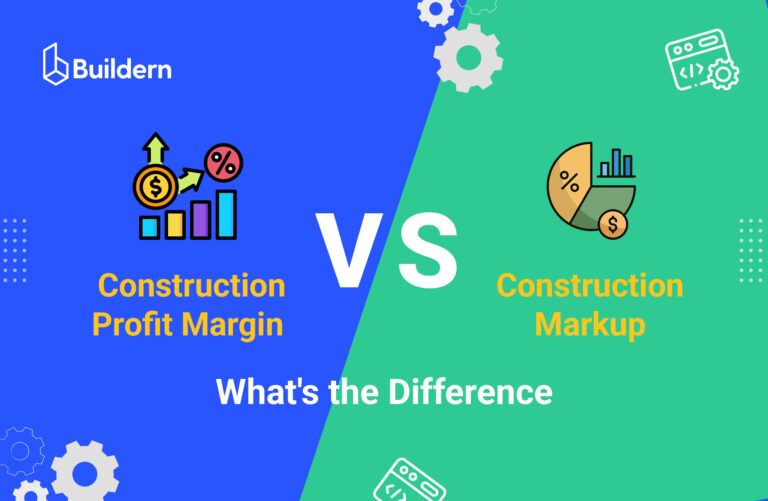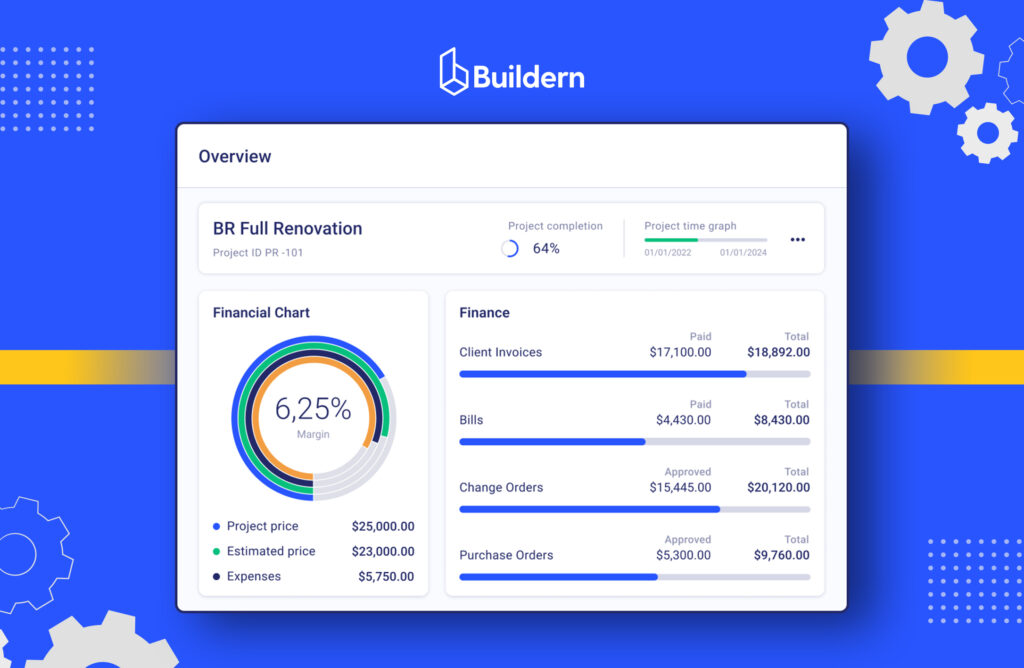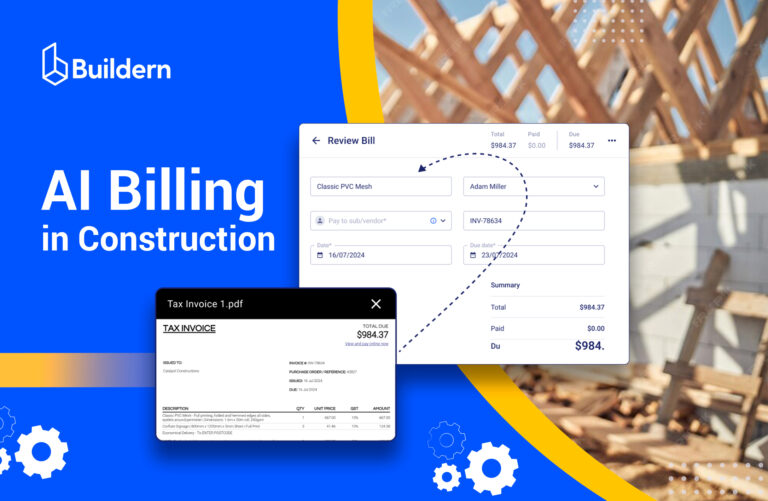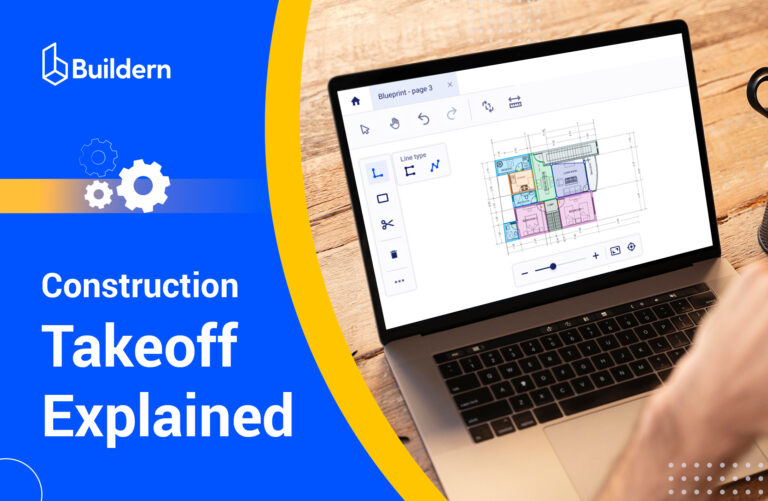Construction Profit Margin vs. Markup: Guide for Contractors

Construction profit margin vs. markup is one of the most misunderstood financial concepts in the industry. Many contractors confuse the two, resulting in underpriced bids and disappointing profits. Understanding how to calculate profit margin and markup correctly is essential to pricing jobs effectively and running a profitable construction business.
In this guide, we clarify the difference between them, show you how to calculate both with confidence, and explain when and why to use each. Whether you’re pricing your next project or evaluating your company’s financial health, understanding this distinction is critical.
Table of Contents
- Why Construction Businesses Get This Wrong (And Why It Matters)
- How to Calculate Profit Margin in Construction
- How to Calculate Markup in Construction
- Average Profit Margins in Different Construction Sectors
- Strategic Implementation: Using Margin and Markup Effectively
- Common Construction Profit Margin vs. Markup Mistakes (and How to Avoid Them)
- Dynamic Markup Management Solutions
- To Wrap Up: Profit Margin vs. Markup

What’s the Difference Between Profit Margin and Markup?
| Profit Margin | Markup | |
| Definition | Profit as a percentage of revenue | Profit as a percentage of cost |
| Formula | (Revenue – Cost) / Revenue × 100 | (Revenue – Cost) / Cost × 100 |
| Focus | Bottom-line profitability | Pricing based on cost |
| Use Case | Reporting, financial analysis | Estimating, bidding |
| Main Question | “How much profit do I keep?” | “What should I charge to hit my margin?” |
Profit margin vs. markup are two fundamental ways to measure profitability in construction, but they are not interchangeable. While both deal with the relationship between costs and revenue, they’re calculated differently, serve different purposes, and can produce significantly different results if misused.
When pricing jobs, evaluating performance, or setting long-term project targets, understanding the distinction is critical.
Profit Margin Explained
Profit margin shows how much of your total revenue remains as profit after covering all project costs. It’s expressed as a percentage of the selling price (revenue), providing a big-picture view of how efficiently your business turns income into actual profit.
Grab the formula:
Profit Margin (%) = (Revenue – Costs) / Revenue × 100
👉 For example, if your project costs $80,000 and you apply a 25% markup, your selling price becomes $100,000. That means your profit is $20,000. To calculate your profit margin, use this formula:
($100,000 – $80,000) / $100,000 × 100 = 20%
| Metric | Value |
| Cost | $80,000 |
| Markup (25%) | $20,000 |
| Selling Price | $100,000 |
| Profit Margin | 20% |
This means for every dollar earned, you keep 20 cents as profit.
When to Use Profit Margin
Think of profit margin as your strategic lens for evaluating overall profitability and making informed business decisions. It’s especially valuable in situations like:
- Evaluating company performance: Track financial results across projects or periods to identify trends and improvement areas.
- Reporting to investors or applying for loans: A strong profit margin signals financial health to lenders and stakeholders.
- Analyzing project types or client segments: Pinpoint which services or clients yield the highest returns
💡 Profit margin is a key metric in strategic planning; it helps answer the question, “How profitable are we?”
Markup Explained
Markup represents how much you increase your costs to determine the selling price. Rather than focusing on what’s left over after expenses, it starts with your costs and builds upward to ensure your desired profit is included.
Grab the formula:
Markup (%) = (Revenue – Costs) / Costs × 100
Using the same example:
($100,000 – $80,000) / $80,000 × 100 = 25%
So, in this case, you marked up your $80,000 in costs by 25% to arrive at a $100,000 selling price.
When to Use Markup
Markup is most useful during the pricing and estimating stage, helping you ensure profitability on a per-project basis by building profit into your cost-based quotes. Use it:
- During project estimating and bid preparation: Apply markup to material, labor, and subcontractor costs to arrive at a competitive yet profitable bid.
- To ensure all direct and indirect costs are covered, plus a target profit: Markups help you build in overhead and margin so you’re not underpricing your services.
- When developing pricing models or quoting on the fly from known cost figures: It offers a quick way to calculate a selling price when you already know your base costs.
💡 Markup is practical in day-to-day operations because it answers the question, “What should I charge to hit my profit goals?”
The Critical Difference: Why It Matters
Although they use the same numbers, profit margin and markup yield different percentages:
- Profit margin: 20%
- Markup: 25%
This distinction is more than academic as it directly affects your pricing strategy and bottom line.
Contractors often make the mistake of targeting a specific profit margin but calculating prices using a markup that doesn’t support that goal.
👉 For instance, aiming for a 20% margin but applying a 20% markup will only result in a 16.7% margin, significantly less profit than intended. This gap is one of the most common causes of underbidding and missed profit targets in construction.

Why Construction Businesses Get This Wrong (And Why It Matters)
According to a Construction Financial Management Association study, nearly 35% of construction businesses miscalculate their profit targets by confusing margin and markup. This confusion isn’t just an accounting technicality, it can directly impact your bottom line.
Let’s consider this real-world example:
| Target Profit | Calculation Method | Job Cost | Price Quoted | Actual Profit |
| 20% | Using Margin (Correct) | $80,000 | $100,000 | 20% |
| 20% | Using Markup (Incorrect) | $80,000 | $96,000 | 16.7% |
The $4,000 difference might seem small, but this contractor could lose over $60,000 in potential profits across multiple projects annually.
How to Calculate Profit Margin in Construction
Basic Profit Margin Formula
For any construction project, calculate your profit margin using:
Profit Margin (%) = (Project Revenue – Total Project Costs) / Project Revenue × 100
What to Include in Total Project Costs
Accurate pricing starts with a full understanding of all costs associated with a project. Comprehensive project costs should account for both direct and indirect expenses:
Direct Costs
- Materials
- Labor (including benefits and payroll taxes)
- Equipment rental/depreciation
- Subcontractor fees
- Site-specific permits and fees
Indirect Costs (allocated proportionally)
- Project management time
- Administrative overhead
- Insurance
- Marketing and sales costs for acquiring the project
- Office expenses
- Vehicle expenses
💡 Pro Tip: Many contractors underestimate indirect costs by as much as 15%, according to research from Construction Business Owner magazine. We recommend tracking these costs diligently for at least 3-6 months to establish accurate allocation rates.
👉 Example: Calculating Net Profit Margin for a Construction Project
For a $250,000 residential renovation project:
- Direct Costs: $175,000
- Indirect Costs: $25,000
- Total Costs: $200,000
- Revenue: $250,000
Profit Margin = ($250,000 – $200,000) / $250,000 × 100 = 20%
💡 Recommended Reading: 5 Types of Construction Cost Estimation and How to Do It
How to Calculate Markup in Construction
➡️ Basic Markup Formula
Markup (%) = (Project Revenue – Total Project Costs) / Total Project Costs × 100
Alternatively, to determine the selling price from known costs:
Selling Price = Total Project Costs × (1 + (Markup % / 100))
👉 Example: Converting Desired Profit Margin to Required Markup
If you want to achieve a 25% profit margin, you need to calculate the equivalent markup:
Required Markup % = Desired Profit Margin % / (100% – Desired Profit Margin %)
Required Markup % = 25% / (100% – 25%) = 25% / 75% = 33.33%
This means you need to mark up your costs by 33.33% to achieve a 25% profit margin.
Profit Margin vs. Markup Conversion Chart
To help you quickly convert between margin and markup, we’ve created this reference chart:
| Desired Profit Margin | Required Markup |
| 10% | 11.1% |
| 15% | 17.6% |
| 20% | 25% |
| 25% | 33.3% |
| 30% | 42.9% |
| 35% | 53.8% |
| 40% | 66.7% |
💡 Pro Tip: Keep this chart handy when preparing bids. We’ve found it particularly useful during our consultation work with specialty contractors who need to make quick pricing decisions.
Average Profit Margins in Different Construction Sectors
Based on data from the Associated General Contractors of America and our industry experience, here are typical profit margins across different construction sectors:
| Construction Sector | Average Profit Margin Range |
| Residential Construction | 8-12% |
| Commercial Construction | 10-15% |
| Specialty Trades | 12-18% |
| Heavy/Civil Construction | 9-13% |
| Industrial Construction | 10-16% |
It’s important to note that these figures represent industry averages. Top-performing companies typically achieve margins 3-5% points higher through efficient operations and strategic pricing.
Strategic Implementation: Using Margin and Markup Effectively
When to Focus on Profit Margin
➡️ Financial Reporting and Analysis
- Use profit margin when assessing your business’s financial health
- Compare profit margins across different project types to identify your most profitable work
- Track profit margin trends over time to measure improvement
➡️ Investor or Lender Communications
- Financial institutions and investors typically evaluate businesses based on profit margins
- Industry comparisons are usually made using profit margin percentages
When to Focus on Markup
- Project Pricing and Bidding
- Calculate the required markup based on your desired profit margin
- Apply different markup rates to different cost categories (materials vs. labor)
- Account for risk factors by adjusting the markup on uncertain project elements
- Quick Pricing Decisions
- Use markup when you need to quickly calculate a selling price from known costs
- Implement tiered markup strategies for different project sizes or types
Common Construction Profit Margin vs. Markup Mistakes (and How to Avoid Them)
Mistake #1: Using Industry-Standard Markups Without Calculation
Many contractors simply use “standard” markup rates they’ve heard from colleagues without calculating whether these rates deliver their desired profit margins.
💡 Solution: Calculate your own required markup based on your specific cost structure and desired profit margins. What works for one company may not work for yours.
Mistake #2: Not Differentiating Between Cost Types
Applying the same markup percentage to all costs ignores the different risk levels and overhead requirements of various cost categories.
💡 Solution: Consider implementing variable markup rates:
- Apply higher markups on labor, which tends to be less predictable and higher risk.
- Use lower markups on high-ticket items like materials or equipment to stay competitive.
- Consider premium markups for specialized or niche services with limited competition.
Mistake #3: Failing to Account for Project Size
Using the same markup percentage on both small and large jobs can hurt your profitability. Smaller projects often require more admin time relative to revenue.
💡 Solution: Implement a sliding scale markup system that adjusts based on project size. Smaller jobs typically need higher markups to cover fixed costs and still deliver a profit. Let’s look at the table below:
| Project Size | Recommended Markup |
| Under $50,000 | 35-45% |
| $50,000-$250,000 | 28-35% |
| $250,000-$1,000,000 | 22-28% |
| Over $1,000,000 | 18-25% |
Technology Tools for Accurate Margin and Markup Management
Modern construction management software has made tracking costs and applying appropriate markups easier than ever. Based on our testing and client feedback, Buildern’s solutions offer the best margin/markup features:
Dynamic Markup Management Solutions
There is a construction software platform that stands out for offering advanced features tailored to managing markup and profit margins more effectively. These tools go beyond basic cost tracking, giving contractors the flexibility and control needed to protect profitability across projects. One notable solution includes functionality that allows users to:
- Create custom markup rules based on project type, client profile, or material category
- Automatically apply variable markup rates across different cost categories
- Generate real-time profitability forecasts during the estimation phase
- Monitor and adjust margins as project costs evolve
- Set up multi-tier approval workflows for markup exceptions to maintain oversight
These advanced markup management capabilities have helped several of our consulting clients increase their average profit margins without losing bid competitiveness.
Integrated Financial Dashboards
The most effective construction management platforms now include financial dashboards that provide:
- Side-by-side comparisons of estimated vs. actual profit margins
- Visual representations of markup distribution across cost categories
- Automated alerts when projects fall below target profit thresholds
- Historical profit trends by project type, size, and location
- Prediction models that suggest optimal markup rates based on past performance

Technology Tools for Accurate Profit Margin vs. Markup Management
In practice, construction management software has made it easier than ever to track costs, control markups, and protect profit margins. Manual calculations and spreadsheets often are the blockers that erode profitability. Luckily, Buildern’s integrated financial tools significantly reduce the administrative burden of tracking profitability while providing actionable insights for pricing future projects.
Similarly, its Estimating module connects project estimates to real-time job costing, promoting more accurate and profitable bids from the start.
You can monitor budget variances, track labor and material costs in real time, and receive automated alerts when profit margins fall below target thresholds. Buildern’s financial dashboards also visualize performance across projects & make it easier to identify trends, forecast cash flow, and refine pricing strategies as jobs progress.

Practical Implementation Steps
Improving profit margins requires more than adjusting a few numbers. It calls for a clear understanding of your current performance, a disciplined markup strategy, and reliable processes to support it. The steps below provide a structured approach to help contractors take control of their pricing, strengthen estimating practices, and improve project profitability over time:
1️⃣ Audit Your Current Situation
- Calculate your actual profit margins from the past 10-15 projects
- Compare your target margins to what you achieved
- Identify patterns in underperforming projects
2️⃣ Develop Your Markup Strategy
- Calculate the correct markup needed to achieve your desired margin
- Create a markup structure that accounts for different cost categories
- Document your markup policy and train your team on implementation
3️⃣ Build Better Estimating Processes
- Implement checks and balances to ensure the markup is correctly applied
- Create estimation templates that automatically calculate prices based on your markup strategy
- Establish review procedures for bids before they go out
4️⃣ Leverage Modern Estimation Tools
- Utilize construction software with built-in markup calculation tools
- Implement digital takeoff features that integrate with your markup formulas
- Set up automated approval workflows for estimates that fall outside target margin ranges
5️⃣ Streamline Change Order Management
- Use digital change order systems that automatically apply your predetermined markup rules
- Implement electronic signature capabilities to expedite approvals
- Track change order profit margins separately to identify additional profit opportunities
6️⃣ Monitor and Refine
- Review completed project profitability against the estimates monthly
- Track margin trends by project type, size, and client
- Adjust your markup strategy based on performance data
- Use data visualization tools to identify profit patterns across different project categories
To Wrap Up: Profit Margin vs. Markup
Understanding the distinction between profit margin and markup isn’t just accounting semantics but fundamental to running a sustainable and profitable construction business. By implementing the strategies outlined in this guide, you’ll avoid the common setbacks that lead to unprofitable projects and position your company for stronger financial performance.
Remember that the most successful contractors don’t compete solely on price; they understand their costs thoroughly, price strategically, and deliver value that justifies their margins. Take time this quarter to review your pricing strategies and ensure you’re correctly calculating the markup needed to achieve your desired profit margins!



